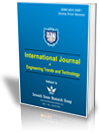Heart Disease Prediction Using a Novel Fuzzy-Enhanced CLSTM Model with Adaptive Stochastic Gradient Descent Optimization
Heart Disease Prediction Using a Novel Fuzzy-Enhanced CLSTM Model with Adaptive Stochastic Gradient Descent Optimization |
||
 |
 |
|
| © 2025 by IJETT Journal | ||
| Volume-73 Issue-3 |
||
| Year of Publication : 2025 | ||
| Author : R. Parthiban, K. Santhosh Kumar |
||
| DOI : 10.14445/22315381/IJETT-V73I3P135 | ||
How to Cite?
R. Parthiban, K. Santhosh Kumar, "Heart Disease Prediction Using a Novel Fuzzy-Enhanced CLSTM Model with Adaptive Stochastic Gradient Descent Optimization," International Journal of Engineering Trends and Technology, vol. 73, no. 3, pp. 503-516, 2025. Crossref, https://doi.org/10.14445/22315381/IJETT-V73I3P135
Abstract
Cardiovascular Diseases (CVDs) are considered to be the predominant cause of the increase in death rates around the world. Hence, early detection is mandatory for managing and providing the affected persons with effective treatment. Normally, capturing complex patterns in medical data is much more difficult with the help of traditional machine learning methods. Although it is more effective, it is not able to handle the uncertainty and non-linearity problem that exists in the patient’s health metrics. In this study, a novel approach called Fuzzy-Enhanced CLSTM is proposed for heart disease prediction. This novel approach integrates Multilayer Fuzzy-based Convolutional Neural Networks (MFCNN) in correlation with the Bidirectional Long Short-Term Memory (BiLSTM) model. In this method, the fuzzy logic is leveraged to enhance the feature extraction process of CNN by making it more robust in dealing with imprecise and uncertain data. Including fuzzification will enhance the sensitivity to a certain extent by supporting the critical variations in the clinical parameters. Combining convolutional neural networks with the BiLSTM will capture the temporal dependencies in sequential data, enabling a more comprehensive understanding of patient history and trends over time. Hence, this model is suitable for both spatial feature extraction and temporal analysis. Fine-tuning of the model is performed using an Adaptive Stochastic Gradient Descent (ASGD) optimizer, which dynamically adjusts the learning rate during training. This helps faster convergence and prevents the model from getting stuck in local minima by improving overall prediction accuracy. The experimental results conducted by using publicly available datasets provide significant improvement in early and accurate heart disease detection and prediction by providing better accuracy and generalization compared to other traditional Methods.
Keywords
Heart disease prediction, Cardiovascular diseases, Fuzzy-based CNN, Adaptive stochastic gradient descent, BiLSTM, Deep learning.
References
[1] Xiaoyu Sun et al., “Artificial Intelligence in Cardiovascular Diseases: Diagnostic and Therapeutic Perspectives,” European Journal of Medical Research, vol. 28, no. 1, pp. 1-11, 2023.
[CrossRef] [Google Scholar] [Publisher Link]
[2] Ram Jagannathan et al., “Global Updates on Cardiovascular Disease Mortality Trends and Attribution of Traditional Risk Factors,” Current Diabetes Reports, vol. 19, 2019.
[CrossRef] [Google Scholar] [Publisher Link]
[3] Zeeshan Ahmed et al., “Artificial Intelligence with Multi-Functional Machine Learning Platform Development for Better Healthcare and Precision Medicine,” Database, vol. 2020, pp. 1-35, 2020.
[CrossRef] [Google Scholar] [Publisher Link]
[4] Fuad Ali Mohammed Al-Yarimi et al., “Feature Optimization by Discrete Weights for Heart Disease Prediction Using Supervised Learning,” Soft Computing, vol. 25, pp. 1821-1831, 2021.
[CrossRef] [Google Scholar] [Publisher Link]
[5] Bharat Singh, Rajesh Kumar, and Vinay Pratap Singh, “Reinforcement Learning in Robotic Applications: A Comprehensive Survey,” Artificial Intelligence Review, vol. 55, no. 2, pp. 945-990, 2022.
[CrossRef] [Google Scholar] [Publisher Link]
[6] Chayakrit Krittanawong et al., “Artificial Intelligence in Precision Cardiovascular Medicine,” Journal of the American College of Cardiology, vol. 69, no. 21, pp. 2657-2664, 2017.
[Google Scholar] [Publisher Link]
[7] Essam H. Houssein, Rehab E. Mohamed, and Abdelmgeid A. Ali, “Heart Disease Risk Factors Detection from Electronic Health Records Using Advanced NLP and Deep Learning Techniques,” Scientific Reports, vol. 13, no. 1, pp. 1-19, 2023.
[CrossRef] [Google Scholar] [Publisher Link]
[8] Tauhidul Islam et al., “A Systematic Review of Deep Learning Data Augmentation in Medical Imaging: Recent Advances and Future Research Directions,” Healthcare Analytics, vol. 5, pp. 1-18, 2024.
[CrossRef] [Google Scholar] [Publisher Link]
[9] William DeGroat et al., “Discovering Biomarkers Associated and Predicting Cardiovascular Disease with High Accuracy Using A Novel Nexus of Machine Learning Techniques for Precision Medicine,” Scientific Reports, vol. 14, no. 1, pp. 1-13, 2024.
[CrossRef] [Google Scholar] [Publisher Link]
[10] Manju Payal, K. Suresh Kumar, and T. Ananth Kumar, “Recent Advances of Machine Learning Techniques in Biomedicine,” International Journal of Multidisciplinary Research in Science, Engineering and Technology, vol. 5, no. 5, pp. 772-779, 2022.
[Google Scholar]
[11] Paul W. Franks et al., “Precision Medicine for Cardiometabolic Disease: A Framework for Clinical Translation,” The Lancet Diabetes & Endocrinology, vol. 11, no. 11, pp. 822-835, 2023.
[Google Scholar] [Publisher Link]
[12] Fabio Garcea et al., “Data Augmentation for Medical Imaging: A Systematic Literature Review,” Computers in Biology and Medicine, vol. 152, 2023.
[CrossRef] [Google Scholar] [Publisher Link]
[13] Samir S. Yadav, and Shivajirao M. Jadhav, “Detection of Common Risk Factors for Diagnosis of Cardiac Arrhythmia Using Machine Learning Algorithm,” Expert Systems with Applications, vol. 163, 2021.
[CrossRef] [Google Scholar] [Publisher Link]
[14] Ehsan Moghadas, Javad Rezazadeh, and Reza Farahbakhsh, “An IoT Patient Monitoring Based on Fog Computing and Data Mining: Cardiac Arrhythmia Use Case,” Internet of Things, vol. 11, 2020.
[CrossRef] [Google Scholar] [Publisher Link]
[15] Maggie Yu, Mark Harrison, and Nick Bansback, “Can Prediction Models for Hospital Readmission be Improved by Incorporating Patient-Reported Outcome Measures? A Systematic Review and Narrative Synthesis,” Quality of Life Research, vol. 33, pp. 1767-1779, 2024.
[CrossRef] [Google Scholar] [Publisher Link]
[16] Diego Ortego et al., “Multi-Objective Interpolation Training for Robustness to Label Noise,” Proceedings of the IEEE/CVF Conference on Computer Vision and Pattern Recognition, pp. 6606-6615, 2021.
[Google Scholar] [Publisher Link]
[17] Anamika Dhillon, and Gyanendra K. Verma, “Convolutional Neural Network: A Review of Models, Methodologies and Applications to Object Detection,” Progress in Artificial Intelligence, vol. 9, no. 2, pp. 85-112, 2020.
[CrossRef] [Google Scholar] [Publisher Link]
[18] G. Saranya, and A. Pravin, “Hybrid Global Sensitivity Analysis Based Optimal Attribute Selection Using Classification Techniques by Machine Learning Algorithm,” Wireless Personal Communications, vol. 127, no. 3, pp. 2305-2324, 2022.
[CrossRef] [Google Scholar] [Publisher Link]
[19] T.K. Revathi et al., “An Improved Long Short-Term Memory Algorithm for Cardiovascular Disease Prediction,” Diagnostics, vol. 14, no. 3, pp. 1-19, 2024.
[CrossRef] [Google Scholar] [Publisher Link]
[20] Aman Darolia et al., “Enhanced Cardiovascular Disease Prediction through Self-Improved Aquila Optimized Feature Selection in Quantum Neural Network & LSTM Model,” Frontiers in Medicine, vol. 11, 1-18, 2024.
[CrossRef] [Google Scholar] [Publisher Link]
[21] David Opeoluwa, Emmanuel Gbenga Dada, and Sanjay Misra, “Diagnosis of Cardiovascular Diseases by Ensemble Optimization Deep Learning Techniques,” International Journal of Healthcare Information Systems and Informatics, vol. 19, no. 1, pp. 1-21, 2024.
[CrossRef] [Google Scholar] [Publisher Link]
[22] Govindaraj Ramkumar et al., “IoT-Based Patient Monitoring System for Predicting Heart Disease Using Deep Learning,” Measurement, vol. 218, 2023.
[CrossRef] [Google Scholar] [Publisher Link]
[23] MD Mobin Akhtar et al., “IoMT-Based Smart Healthcare Monitoring System Using Adaptive Wavelet Entropy Deep Feature Fusion and Improved RNN,” Multimedia Tools and Applications, vol. 82, no. 11, pp. 17353-17390, 2023.
[CrossRef] [Google Scholar] [Publisher Link]
[24] Manju Payal, T. Ananth Kumar, and K. Suresh Kumar, “Integrating Natural Language Processing (NLP) and Machine Learning Techniques for Healthcare Industries,” International Journal of Innovative Research in Computer and Communication Engineering, vol. 10, no. 5, pp. 3030-3036, 2022.
[Google Scholar] [Publisher Link]
[25] Mingle Xu et al., “A Comprehensive Survey of Image Augmentation Techniques for Deep Learning,” Pattern Recognition, vol. 137, pp. 1-12, 2023.
[CrossRef] [Google Scholar] [Publisher Link]
[26] Iqbal H. Sarker, “Deep Learning: A Comprehensive Overview on Techniques, Taxonomy, Applications and Research Directions,” SN Computer Science, vol. 2, pp. 1-20, 2021.
[CrossRef] [Google Scholar] [Publisher Link]
[27] Apeksha Shewalkar, Deepika Nyavanandi, and Simone A. Ludwig, “Performance Evaluation of Deep Neural Networks Applied to Speech Recognition: RNN, LSTM and GRU,” Journal of Artificial Intelligence and Soft Computing Research, vol. 9, no. 4, pp. 235-245, 2019.
[CrossRef] [Google Scholar] [Publisher Link]
[28] Qinfeng Zhu, Lei Fan, and Ningxin Weng, “Advancements in Point Cloud Data Augmentation for Deep Learning: A Survey,” Pattern Recognition, vol. 153, 2024.
[CrossRef] [Google Scholar] [Publisher Link]
[29] De Jong Yeong et al., “Sensor and Sensor Fusion Technology in Autonomous Vehicles: A Review,” Sensors, vol. 21, no. 6, pp. 1-37, 2021.
[CrossRef] [Google Scholar] [Publisher Link]
[30] Vinay Singh et al., “How are Reinforcement Learning and Deep Learning Algorithms Used for Big Data Based Decision Making in Financial Industries-A Review and Research Agenda,” International Journal of Information Management Data Insights, vol. 2, no. 2, pp. 1-15, 2022.
[CrossRef] [Google Scholar] [Publisher Link]
[31] Fadi AlMahamid, and Katarina Grolinger, “Autonomous Unmanned Aerial Vehicle Navigation Using Reinforcement Learning: A Systematic Review,” Engineering Applications of Artificial Intelligence, vol. 115, 2022.
[CrossRef] [Google Scholar] [Publisher Link]
[32] Luca Bertolaccini et al., “Recent Advances in Lung Cancer Research: Unravelling the Future of Treatment,” Updates in Surgery, vol. 76, pp. 2129-2104, 2024.
[CrossRef] [Google Scholar] [Publisher Link]
[33] Thesath Nanayakkara et al., “Unifying Cardiovascular Modelling with Deep Reinforcement Learning for Uncertainty Aware Control of Sepsis Treatment,” PLOS Digital Health, vol. 1, no. 2, pp. 1-20, 2022.
[CrossRef] [Google Scholar] [Publisher Link]
[34] Cristian Drudi et al., “A Reinforcement Learning Model for Optimal Treatment Strategies in Intensive Care: Assessment of the Role of Cardiorespiratory Features,” IEEE Open Journal of Engineering in Medicine and Biology, vol. 5, pp. 806-815, 2024.
[CrossRef] [Google Scholar] [Publisher Link]
[35] Smitesh Padte et al., “21st Century Critical Care Medicine: An Overview,” World Journal of Critical Care Medicine, vol. 13, no. 1, pp. 1-15, 2024.
[CrossRef] [Google Scholar] [Publisher Link]
[36] Jun Ma et al., “Analyzing Driving Factors of Land Values in Urban Scale Based on Big Data and Non-Linear Machine Learning Techniques,” Land Use Policy, vol. 94, 2020.
[CrossRef] [Google Scholar] [Publisher Link]
[37] Jagmohan Kaur, and Baljit S. Khehra, “Fuzzy Logic and Hybrid Based Approaches for the Risk of Heart Disease Detection: State-of-the-Art Review,” Journal of the Institution of Engineers (India): Series B, vol. 103, pp. 681-697, 2022.
[CrossRef] [Google Scholar] [Publisher Link]
[38] L.J. Muhammad, and Ebrahem A. Algehyne, “Fuzzy Based Expert System for Diagnosis of Coronary Artery Disease in Nigeria,” Health and Technology, vol. 11, pp. 319-329, 2021.
[CrossRef] [Google Scholar] [Publisher Link]
[39] Mario Malcangi, and Giovanni Nano, “Biofeedback: e-Health Prediction Based on Evolving Fuzzy Neural Network and Wearable Technologies,” Evolving Systems, vol. 12, pp. 645-653, 2021.
[CrossRef] [Google Scholar] [Publisher Link]

